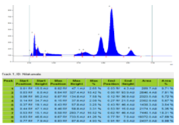Abstract
In Ayurveda many Ayurvedic formulations are explained, which used to treat a variety of illness since ancient time and to protect patient faith in Ayurveda and Ayurvedic treatment, scientifically proven safety, standard and quality of herbs is the need of the hour. Nilotpaladi yoga (NY) is mentioned in Ayurvedic texts for the Treatment of Raktatisara (~haemorrhagic diarrohea). Nilotpaladi yoga consists of four ingredients such as Nilakamala (Nymphaea nouchali Burm. f.), Mocharasa (Salmalia malabarica Schott & Endl.), Lajavanti (Mimosa pudica Linn.) and Kamalakesara (Nelumbo nucifera Gaertn.). Nilotpaladi yoga ingredient like Mochrasa (Salmalia malabarica Schott & Endl.) is known to be effective as Shonita sthapaka gana (a group of drugs that act as haemostatics). Physiochemical analysis of Nilotpaladi yoga is not explored in detail. So, this article is an attempt to present a physiochemical analysis of ingredients of Nilotpaladi yoga by using Modern analytical Techniques. Physio-chemical analysis, HPTLC etc., were carried out as per standard methods.
Full text article
References
Bensky, D., Clavey, S., Stoger, E. 2015. ’Chinese Herbal Medicine: Materia Medica’. Seattle (WA). ISBN: 0-939-616-82-3. Eastland Press; 3rd edition, pages 0–939.
Dhalwal, K., Shinde, V. M., Biradar, Y. S., Mahadik, K. R. 2008. Simultaneous quantification of bergenin, catechin, and gallic acid from Bergenia ciliata and Bergenia ligulata by using thin-layer chromatography. Journal of Food Composition and Analysis, 21(6):496–500.
Hussain, L., Akash, M. S. H., Naseem, S., Rehman, K., Ahmed, K. Z. 2015. Anti-Ulcerogenic Effects of Salmalia Malabarica in Gastric Ulceration Pilot Study. Advances in Clinical and Experimental Medicine, 24(4):595–605.
Jagtap, A. G., Niphadkar, P. V., Phadke, A. S. 2011. Protective effect of aqueous extract of Bombax malabaricum DC on experimental models of inflammatory bowel disease in rats and mice. Indian Journal of Experimental Biology, 49(5):343– 351.
Li, M., Xu, Z. 2008. Quercetin in a lotus leaves extract may be responsible for antibacterial activity. Archives of Pharmacal Research, 31(5):640– 644.
Shukla, V., Tripathi, R. D. 2002a. Charaka Samhita’. Chikitsasthana, Pages-477. Varanasi, India. Chaukhambha Sanskrit Sansthan.
Shukla, V., Tripathi, R. D. 2002b. Charaka Samhita’. Chikitsasthana, Pages-478, 19/75. Varanasi, India. Chaukhambha Sanskrit Sansthan.
Singh, M. P. 2005. ‘Panda H. Medicinal Herbs and their Formulations. New Delhi. ISBN: 9788170355809, 1:176–184.
Srikanth, N., Singh, A., Ota, S., Sreedhar, B., Galib, Dhiman, K. S. 2019. Chemical characterization of an Ayurvedic herbo-mineral preparation-Maha-laxmivilas Rasa. Journal of Ayurveda and Integrative Medicine, 10(4):262–268.
Vasu, K., Singaracharya, M. A. 2008. Antimicrobial activity of certain aquatic angiosperms against some pathogenic bacteria. Biotechnology & Environmental Sciences Paper, 10:609–622.
Williamson, E. M. 2002. ’Major Herbs of Ayurveda. Edinburgh’. ISBN: 0443072035. Churchill Living stone, page 261.
Yang, D., Wang, Q., Ke, L., Jiang, J., Ying, T. 2007. Antioxidant activities of various extracts of lotus (Nelumbo nuficera Gaertn) rhizome. Asia Pacific Journal of Clinical Nutrition, 16(1):158–163.
Authors

This work is licensed under a Creative Commons Attribution-NonCommercial-NoDerivatives 4.0 International License.

